Birds in the News #19
Birds in Science:
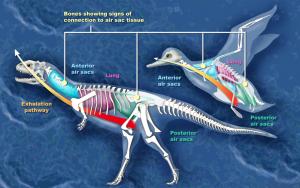 A newly published paper in the top-tier scientific journal, Nature, reveals that predatory dinosaurs had bird-like pulmonary system. "What was once formally considered unique to birds was present in some form in the ancestors of birds," said Patrick O'Connor, an assistant professor of biomedical sciences at Ohio University's College of Osteopathic Medicine and lead author on the study, which was funded in part by the National Science Foundation. Birds long have fascinated biologists because of their unusual pulmonary system. Pulmonary air sacs prompt air to pass through the lungs twice during ventilation, which makes it the most efficient ever known. This system also creates holes in the skeleton of birds, which has led to a popular notion that birds have "air in their bones," O'Connor said. [An added bonus for you, dear readers, is PZ Myers' fine piece describing the dinosaur (and bird) respiratory system.]
A newly published paper in the top-tier scientific journal, Nature, reveals that predatory dinosaurs had bird-like pulmonary system. "What was once formally considered unique to birds was present in some form in the ancestors of birds," said Patrick O'Connor, an assistant professor of biomedical sciences at Ohio University's College of Osteopathic Medicine and lead author on the study, which was funded in part by the National Science Foundation. Birds long have fascinated biologists because of their unusual pulmonary system. Pulmonary air sacs prompt air to pass through the lungs twice during ventilation, which makes it the most efficient ever known. This system also creates holes in the skeleton of birds, which has led to a popular notion that birds have "air in their bones," O'Connor said. [An added bonus for you, dear readers, is PZ Myers' fine piece describing the dinosaur (and bird) respiratory system.] 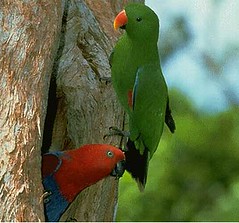 The lovely Eclectus parrot, Eclectus roratus, endemic to Australia and several South Pacific islands, has always mystified humans with their astonishing colors. Unlike most parrot species, this species has color-coded males and females (dimorphic plumage coloration); males are brilliant emerald while females are shocking scarlet. So different are the sexes that for many decades, the males and females were classified as different species! Why are female Eclectus parrots more brightly colored than their mates? Australian National University researcher Robert Heinsohn and colleagues studied this centuries-old question by looking at the birds through avian eyes. Basically, the female's brilliant coloring comes in handy before nesting. Since nest cavities are rare commodities and because a competitor's first view of a potential nest tree is typically from above where the resident female spends most of her time just prior to breeding, her brilliant colors let others know this nest cavity is taken! This research was published today in the top-tier scientific journal, Science.
The lovely Eclectus parrot, Eclectus roratus, endemic to Australia and several South Pacific islands, has always mystified humans with their astonishing colors. Unlike most parrot species, this species has color-coded males and females (dimorphic plumage coloration); males are brilliant emerald while females are shocking scarlet. So different are the sexes that for many decades, the males and females were classified as different species! Why are female Eclectus parrots more brightly colored than their mates? Australian National University researcher Robert Heinsohn and colleagues studied this centuries-old question by looking at the birds through avian eyes. Basically, the female's brilliant coloring comes in handy before nesting. Since nest cavities are rare commodities and because a competitor's first view of a potential nest tree is typically from above where the resident female spends most of her time just prior to breeding, her brilliant colors let others know this nest cavity is taken! This research was published today in the top-tier scientific journal, Science.This is exactly what george bush wants to hear: Local toxic hotspots in the Arctic are caused by .. sea birds! Canadian researchers, Jules Blais of the University of Ottawa, Ontario, and colleagues, found that lakes in the Arctic that are frequented by northern fulmars, Fulmarus glacialis, can harbour 10-60 times more pollutants than neighbouring, birdless lakes. Pollutants enter the water in the birds' excrement, researchers say. These pollutants include persistent, toxic compounds such as mercury, DDT and hexachlorobenzene (HCB), which were once common ingredients in pesticides and fungicides. This research was published in the top-tier scientific journal, Science.
Scientists discovered that introduced house mice gang up on endangered albatross and kill their chicks. On one of the Earth's most remote islands, Gough Island, a speck in the Atlantic between the southern tips of Africa and South America, mice have learned, and are apparently teaching each other, how to attack and kill bird chicks that are 200 times their size. Scientists found that Tristan albatrosses, Diomedea dabbenena, were losing their chicks at an extremely high rate: up to 80% were dying. Husband-and-wife team Ross Wanless and Andrea Angel spent a year on the island videotaping birds' nests and the videos confirm that mice are taking on the chicks, biting them over and over until they die from loss of blood or infection. Wanless, an invasive-species biologist from the Percy FitzPatrick Institute of African Ornithology at the University of Cape Town, South Africa, vividly recalls watching the first videos. "It was carnage. Chicks half alive, with massive gaping wounds and guts hanging out." The mice take advantage of the fact that the birds, which have evolved in an area that has been without land predators for millions of years, have no defensive response against such attacks.
Bird Flu News:
In the admirable spirit of the 2005 Bush administration and the 1930s Soviet biologist Trofim Lysenko, the Chinese government is ignoring science that it finds "inconvenient". The head of the ministry of agriculture's veterinary bureau, Jia Youling, has rejected research on bird flu published last week in the top-tier scientific journal, Nature, by Yi Guan and his colleagues at the universities of Hong Kong and Shantou. The paper concluded from genetic analysis that the H5N1 bird flu killing migratory birds at Qinghai Lake in northwest China had come from southern China and an independent team in Beijing reported similar findings. Stubborn Chinese officials instead claimed that the virus came from another country. Last week Jia told the official Xinhua news service that Guan's paper "made the wrong conclusion" and "lacks credibility" because birds do not fly to Qinghai from southern China - even though this is a well-known migratory route (click for pictorial link detailing avian migratory routes, also see a more detailed account of Chinese avian migratory routes). Stubborn Chinese officials go one step further than the current American administration by claiming that Guan's group did not go to Qinghai nor did they have permission to do the research, and that his lab does not meet safety standards.
In closely related news, so-called "Trojan Ducks" might be spreading avian influenza throughout Asia, thanks to a mutation in the viral genome that renders it harmless to ducks but deadly to other birds, animals and humans. The H5N1 strain of the virus has been circulating in Southeast Asia since 2002, killing dozens of people in Vietnam, Thailand and Cambodia. At least 97 people have been infected.
Because the Thai people love their fighting cocks to death and refuse to stop or postpone the vile practice of cockfighting despite the threat of avian influenza, Thai officials now issue passports for every cock that records his recent health history to ensure the widely-traveled birds do not add to the spread of avian influenza. The "passport" features the name of the cock's owner, as well as photos of the bird, and close-ups of its shins and head, said Yukol Limlaemthong, head of the Livestock Development Department. Thais are devoted to cockfighting, and prize birds can carry price tags of up to 1 million baht ($23,900).
Birds and Harry Potter:
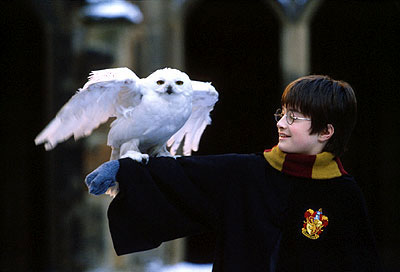
As you all might have surmised from my official blog handle (Hedwig the owl), I am a very devoted fan of the Harry Potter book series. So in honor of the newly released and much anticipated book number 6, Harry Potter and the Half-blood Prince, I was sent the link to this wonderful webpage by Laura Erickson, The Owls of Harry Potter. Interestingly, Laura, whom I correspond with privately, goes by the moniker "Professor McGonagowl" while lecturing publically about owls. Coincidentally, my own students (wizarding apprentices all), decided within the first few days of class that I reminded them of Professor McGonagall (obviously my attempts to impersonate Professor Snape were unsuccessful). [Pictured above: Harry Potter and his pet, Hedwig, the snowy owl, Bubo scandiacus]
Birds in the Media:
Featured this week on the streaming show, BirdNote, were Rock Pigeons, Columba livia -- and why they walk the way they do; the Tufted Puffin, Fratercula cirrhata; the Turkey Vulture, Cathartes aura, and plumage that protects. You can find a linked archive of all past shows and links to other sites of interest at this site. BirdNote can be heard M-F, 8:58-9:00 am on a variety of National Public Radio affiliates throughout Western Washington and Southwest British Columbia, otherwise, if you live elsewhere, you can get this show streaming on the web.
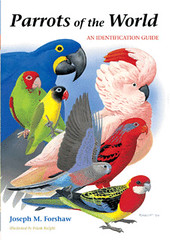 Speaking of books, I cannot resist telling you that the latest catalog from Princeton University Press shows that Joseph M. Forshaw will release his NEW Parrots of the World in February 2006 at $65.00. Guess who is planning to scoop even more cat turds so she can save those extra pennies, nickles and dimes in eager anticipation for this day? [These names are for Ian, who is going to buy me a copy of this book (aren't ya??): species shown on the book cover (top to bottom and left to right); hyacinthine macaw, Anodorhynchus hyacinthinus; red-fronted(?) conure, Aratinga wagleri; black-masked lovebird, Agapornis personata, salmon-crested cockatoo, Cacatua moluccensis; blue-streaked lory, Eos reticulata; Bourke's Parrot, Neophema bourkii; Eastern rosella, Platycercus eximius]
Speaking of books, I cannot resist telling you that the latest catalog from Princeton University Press shows that Joseph M. Forshaw will release his NEW Parrots of the World in February 2006 at $65.00. Guess who is planning to scoop even more cat turds so she can save those extra pennies, nickles and dimes in eager anticipation for this day? [These names are for Ian, who is going to buy me a copy of this book (aren't ya??): species shown on the book cover (top to bottom and left to right); hyacinthine macaw, Anodorhynchus hyacinthinus; red-fronted(?) conure, Aratinga wagleri; black-masked lovebird, Agapornis personata, salmon-crested cockatoo, Cacatua moluccensis; blue-streaked lory, Eos reticulata; Bourke's Parrot, Neophema bourkii; Eastern rosella, Platycercus eximius]Bird Mysteries:
In a previous issue of Birds in the News, I linked to a news story that described the mysterious abandonment of nests by 28,000 pelicans at a wildlife refuge central North Dakota. The plot thickens because this year, US Fish and Wildlife (USFWS) officials are investigating the mysterious deaths of thousands of pelican chicks in this same location. At least 8,000 chicks may have died over the past two months, said Ken Torkelson, a spokesman for the Chase Lake National Wildlife Refuge. The USFWS found that approximately 500 chicks remain from a nesting period that could have produced as many as 9,000 of them. All but about 2,000 adults had left, from a population estimated at 18,850 in late May. White pelicans, Pelecanus erythrorhynchos, are one of the largest birds in North America, breeds only once a year, and males and females take turns caring for their young. The birds have a wingspan of nearly 10 feet and live approximately 25 years.
With a record number of dead seabirds washing up on West Coast beaches from central California to British Columbia, marine biologists are raising the alarm about rising ocean temperatures and dwindling plankton populations. "Something big is going on out there," said Julia Parrish, an associate professor in the School of Aquatic Fisheries and Sciences at the University of Washington. "I'm left with no obvious smoking gun, but birds are a good signal [of environmental disaster] because they feed high up on the food chain." On Washington beaches, bird surveyors in May typically find an average of one dead Brandt's cormorant, Phalacrocorax penicillatus, for every 34 miles of beach. This year, cormorant deaths averaged one for every eight-tenths of a mile, according to data gathered by volunteers with the Coastal Observation and Seabird Survey Team, which Parrish has directed since 2000. "This is somewhere between five and 10 times the highest number of bird deaths we've seen before," she said, adding that she expected June figures to show a similar trend.
People Hurting Birds:
Figures from the British Trust for Ornithology's (BTO) breeding bird census identified an alarming 62 per cent reduction in Scotland's swift population between 1994 and 2003. The problem for swifts, Apus apus, is one of accommodation; the buildings where they traditionally nest are demolished or renovated without any provision being made for replacement nest sites. "Many of our swifts nest in church towers and other buildings," says Duncan Orr-Ewing, head of land use policy for the RSPB in Scotland, adding that modern building methods and materials such as the soffit and fascia boards for sealing roofs all too often stop the birds from getting inside the roofing. "And they are very traditional nesters," he adds. "They will come back to the same site, sometimes for hundreds of years."
Have you ever held a dead eagle? The Bald and Golden Eagle Protection Act says that anyone who so much as collects a fallen eagle feather off a forest floor could face as much as a year in jail and a $5,000 fine. Despite these tight regulations, the system of legal protections and government-controlled distribution of eagle parts to Native Americans is showing signs of breaking down and the demand for eagle feathers is soaring. Black-market prices for eagle feathers and parts are climbing and that could set off a wave of poaching — with disastrous results.
People Helping Birds:
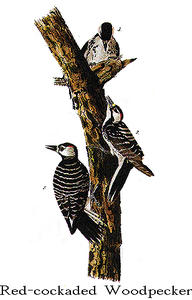
Scientists report good news for another endangered woodpecker species; the population of the severely endangered red-cockaded woodpecker, Picoides borealis, has increased: family groups with three birds or more have increased nearly 30 percent, from 4,694 in 1994 to 6,061. Farming, clear-cutting and commercial forestry deprived them of critical habitat and the woodpeckers were declared endangered in 1970. The Fish and Wildlife Service launched a program in the 1990s to save them. "We have turned the corner," said Ralph Costa, the U.S. Fish and Wildlife Service's red-cockaded woodpecker recovery coordinator in Clemson, S.C.
Carrying binoculars and notebooks, thousands of nature lovers and conservationists scoured semiarid grasslands of western India last Sunday to count a bird considered on the brink of extinction. The great Indian bustard, Ardeotis nigriceps, is long-legged with a black crown on its forehead and stands up to 3 1/2 feet tall. It breeds in grassy plains in western India and its dwindling numbers are the first warning that the grasslands are deteriorating. "Never before has a census been done on such a scale," said conservationist D.R. Panihar about the launch of the first in a series of efforts to protect the bird. "The situation is so alarming that if effective conservation steps are not taken the great Indian bustard will be extinct soon." India ranks third after Indonesia and the Philippines among Asian countries with the most threatened species of birds. Hunting and livestock grazing are the main reasons for halving the population of the great Indian bustard in India in the past six years.
In Hornell, New York, city employees saved an American kestrel chick, Falco sparverius. The hapless fledgling was found floating in a mud puddle in the city garage during one of the region's hideous downpours. The parent birds recently left the fledgling behind to fend for itself, according to Department of Public Works Foreman Mitch Cornish. Thanks to these human heroes, there is one more American kestrel alive today. This short story includes a very cute picture of the rescued bird.
Depending upon the outcome, this story could have either gone into this category or into "People Hurting Birds". In Port Orchard, Washington, a group of feral quaker parrots (also known as the monk parakeet), Myiopsitta monachus, protested vehemently when an expert tore apart the nest they'd built on a decommissioned cellular-phone tower. Fred Olin, a local resident and bird lover, circulated a petition opposing the birds' capture and collected more than 1,000 signatures. Supporters hope the birds will rebuild their nest in Cingular's new cell tower, which is approximately twice as tall as the old 60-footer.
Peculiar Birds:
In Moessingen, Germany, birds have learnt to imitate the ring tones of omnipresent cell phones, say German ornithologists. Jackdaws, starlings and jays were the best mimics, said said Richard Schneider of the NABU Bird Conservation Center near the university city of Tuebingen, Germany. He noted that even practiced birdwatchers [and cell phone chatterers?] were fooled by the birds' ring tones. The birds were simply adapting to their environment in imitating human sounds in what he termed an "evolutionary playground". "The birds have an uncanny ability to mimic these ring tones. This has picked up in tandem with the boom in mobile phone ownership," said Schneider.
Many thanks to my bird watching pals Ian, Caren, Ellen, Robin, Laura, Fred and Ron for sending me some of the links that you are enjoying in this issue of Birds in the News.
Previous : : Birds in the News : : Next
Academic Job Interview Requests: 1
Academic Job Rejections: 1 (from a crappy school, so it doesn't matter)
Non-academic Job Negotiations: wonder of wonders, my little blog might have helped me find a writing job. More details on this if and when I have them.
© 2004, 2005, 2006 by GrrlScientist











7 Peer Reviews:
Someone who used to volunteer where I work has a parrot (African grey, if memory serves) who imitates the ringing of the phone. Drives the woman and her husband nuts, because they are never sure whether it's the bird of the real phone.
That's wonderful news that you might have a job writing! All this fuss about potential employers not hiring people who have blogs--the laugh will be on them in the end. There's a whole generation keeping blogs. They'll be turning down some of the best and brightest candidates they could wish for.
Anyway, I'm keeping my talons crossed for you.
Best of luck with the job. I'm sure you'll be great. If you publish books, I'll buy them...so long as you promise to send me signed copies that future generations will treasure.
What a sweet thing to say, Joeseph! I would be honored to autograph each book that I sell to my fellow bloggers, my birding pals and my friends. Hopefully, I will publish a few books that the general public might enjoy (I already am working on a monograph of my research birds, but won't publish that until after I have some papers published on them).
GrrlScientist
wow i just saw the mice eating the albatross chic . . . graphic; with the bad week that i had and mix in some pms - i started getting sick and wanted to cry . . .
I love that Ms Erickson named her owl Archimedes.
Given the number of in-jokes and classical and literary references in the Harry Potter books, I've been a bit surprised that there haven't been any T.H. White references yet.
At least, none that I've seen so far. I tend to spot something new every time I re-read the books, and I'm sure I have missed a lot of glaringly obvious ones.
--Werewolf32
Woo hoo! A book about parrots that isn't aimed at the pet trade! My b&g macaw and I are pleased!
The quaker story is sticky. I mean, I do love parrots - enough to live with a big messy goofy one - but quakers are introduced and a bit destructive?! What to do . . .
I'll second Joseph in saying that I'd buy a book on birds if you wrote it. Maybe I'm missing something, but the pssitacine literature seems to be lacking in academic rigor. At the least, I'm tempted to say that if you posted some info on your own parrot research here, I'd chip in on that parrot book for you ;). I really, really appreciate these BITN articles . . . though I have to admit I only made it through about 20 seconds of the albatross video before I had to shut it down and go peak at the bird nest in my new front yard (species not yet determined - southern summer laziness).
Yes, Archimedes is such a wonderful name! It rolls off the tongue nicely too.
The albatross video was disturbing, it's really sad to think that something as majestic as an endangered bird species is being lost to the combined insults from tuna fishermen at sea and human-introduced mice on land! I hope something is done quickly to remedy the situation before we lose these birds forever.
I am not sure about the extent of the Monk/quaker parrot damage, since I no longer live in that area, but I am certainly interested to learn more about it. One of my Seattle pals already predicts that I will be the "female version of Mark Bittner". Maybe I will live up to that one day.
I would be most pleased to talk about my research here and I am sure I will in the future, I think. It'll certainly be my Swan Song when it happens, unfortunately, because I have recently given up all hope that I will ever again hold any sort of job in science.
GrrlScientist
Post a Comment
<< Home